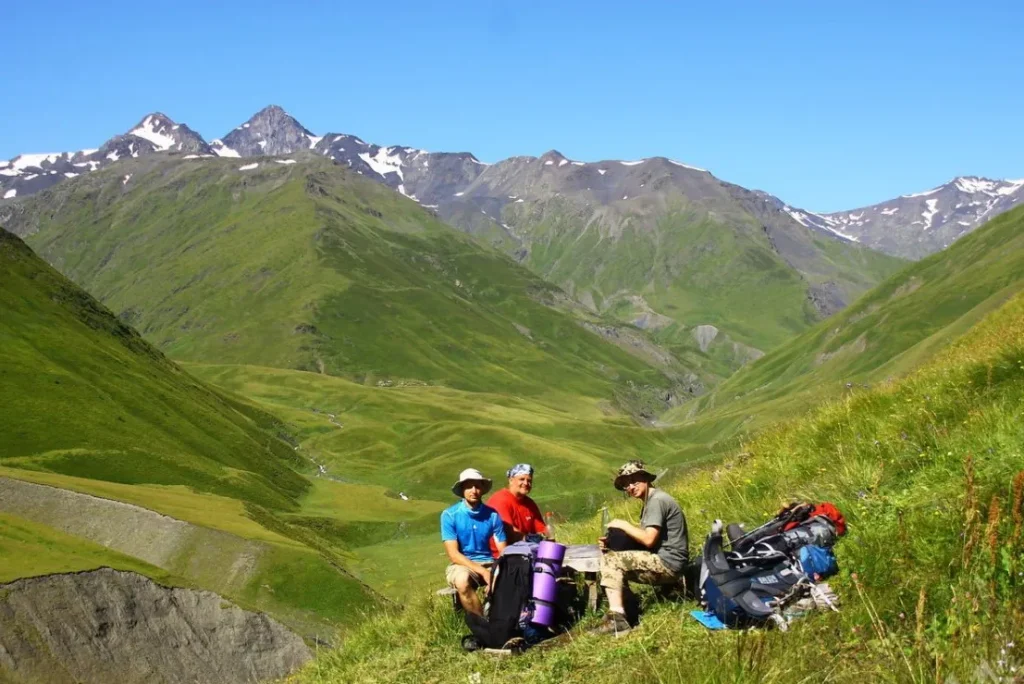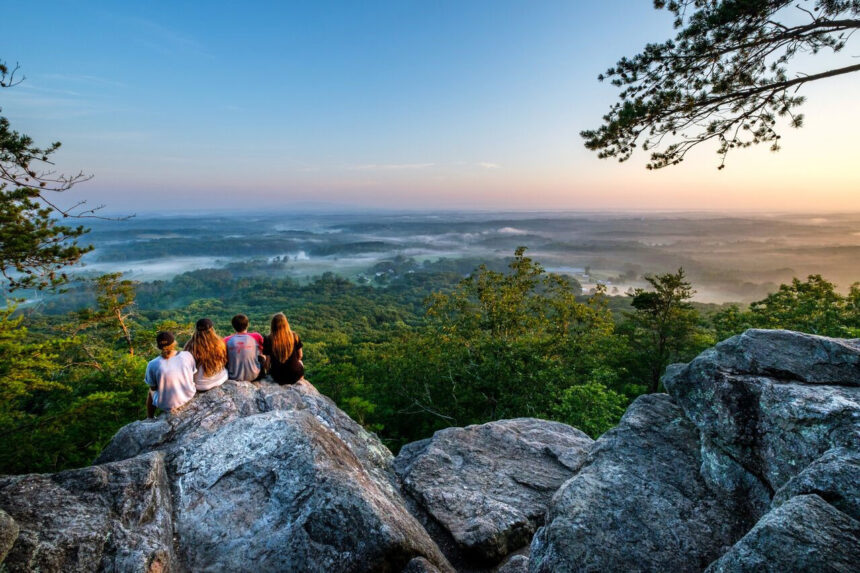Hiking in Georgia mountains offers an unforgettable mix of adventure, natural beauty, and Southern charm. Nestled in the southern Appalachians, Georgia’s mountains boast cascading waterfalls, lush forests, and panoramic overlooks that rival any in the Southeast. Whether you’re an avid trekker or a casual traveler seeking a scenic escape, this comprehensive guide will help you discover the best mountain hikes in Georgia – from easy beginner trails to challenging multi-day journeys. We’ll also share insider tips to plan your trip, answer popular questions, and ensure your Georgia mountain hiking experience is safe, fun, and truly memorable. Let’s hit the trail!
Why Hike in the Georgia Mountains?

Georgia may be famous for peaches and coastal plains, but it also hides a hiker’s paradise in its northern mountain region. Does Georgia have good hiking? Absolutely! The North Georgia Mountains are part of the Blue Ridge chain of the Appalachians, offering diverse trails for all skill levels. In fact, North Georgia’s Southern Appalachians are home to the state’s tallest peaks, with more than 20 summits rising above 4,000 feet. This means you’ll find plenty of opportunities for lofty views and cool mountain air.
One of the best reasons to hike Georgia’s mountains is the sheer variety of scenery. On a single hike, you might stroll past rhododendron tunnels, cross babbling creeks, and emerge onto a rock outcrop with a breathtaking 360° vista of rolling blue hills. Spring brings wildflowers and lush green foliage, summer offers refreshing swimming holes and dense shade, autumn lights up the mountains with brilliant fall colors, and even winter has clear views and peaceful solitude. With a mild climate, Georgia’s hiking season can be year-round, though spring and fall are most popular for comfortable temperatures and scenery.
Georgia’s hiking options are extensive: the Georgia State Parks system alone offers over 600 miles of hiking trails across the state. Meanwhile, the vast Chattahoochee-Oconee National Forest spans nearly 867,000 acres and contains roughly 850 miles of recreation trails, including remote backcountry paths for the adventurous. From easy lake loops to rugged mountain ascents, you’ll never run out of trails to explore. And let’s not forget, Georgia is the southern gateway to the legendary Appalachian Trail (AT) – a bucket-list item for hikers around the world.
Finally, hiking in Georgia mountains is about more than just trails – it’s the whole experience. You can base yourself in a cozy mountain town like Blue Ridge, Helen, or Dahlonega and enjoy local culture, wineries, and comfort after your hikes. Or, for those who prefer luxury, consider staying in a mountain resort or cabin rental; many offer guided hikes or spa services for post-hike relaxation. In short, Georgia’s mountains provide not just great hikes, but also hospitality and amenities that make the journey enjoyable for both outdoor enthusiasts and casual travelers.
Best Mountain Hikes in Georgia: Top Trails and Peaks
What is the best mountain to visit in Georgia? It’s hard to choose just one, as the state is blessed with numerous iconic peaks and trails. Below we highlight some of the best hiking trails in the Georgia mountains – each offering something special, from sweeping summit views to unique natural features. These hikes are sure to impress whether you’re a seasoned hiker or a visitor looking for that one must-see vista.
- Blood Mountain (4,458 ft) – Chattahoochee National Forest. Often cited as one of the top mountains to hike in Georgia, Blood Mountain is famous for its stunning summit views and significance on the Appalachian Trail. In fact, Blood Mountain is the highest peak on the Appalachian Trail in Georgia, offering spectacular panoramas. The most popular route is a 4.3-mile round trip from Neel Gap or Vogel State Park, climbing through forest to large rocky slabs at the top. You’ll find a historic stone shelter at the summit and endless vistas of the Blue Ridge Mountains. Blood Mountain’s combination of moderate distance, rewarding views, and AT lore make it a can’t-miss hike for Georgia travelers.
- Brasstown Bald (4,784 ft) – Brasstown Bald Recreation Area. This is Georgia’s highest mountain, so it absolutely deserves a spot on your itinerary. Brasstown Bald reaches 4,784 feet above sea level, and a steep half-mile paved trail leads from the parking area to an observation tower on the summit. On clear days you can see into four states from the top! The hike is short but very steep – fortunately, a shuttle is available in season if needed. At the summit, enjoy the 360° viewing platform, visitor center exhibits, and cooler temperatures (it’s often 10°F cooler than the lowlands). Brasstown Bald is especially popular in autumn, as it’s among the first places to display fall foliage due to its elevation. Tip: After hiking, drive the scenic Richard B. Russell Byway nearby for more overlooks of the North Georgia mountains.
- Rabun Bald (4,696 ft) – Bartram Trail, Northeast GA. Rabun Bald is Georgia’s second-highest peak and another fantastic viewpoint. A 3.0-mile round trip hike (via the Rabun Bald Trail or Bartram Trail) will take you to its summit, where a wooden observation platform stands (remnant of an old fire tower). From here, you get gorgeous 360° views of the surrounding mountains and valleys – it’s said you can see as far as 100 miles on a clear day. Rabun Bald’s moderate trail and big payoff make it a favorite among local hikers, but it’s far less crowded than Brasstown Bald. Fun fact: According to folklore, Rabun Bald is haunted by fire tower watchmen of the past – though you’re more likely to be enchanted by the scenery than spooked by ghosts!
- Yonah Mountain (3,166 ft) – Cleveland, GA. Don’t let the elevation number fool you – Yonah is a prominent granite peak that rises impressively above the surrounding countryside. The 4.4-mile round trip Yonah Mountain Trail is a steep and strenuous climb, but it has become “something of a rite of passage for Georgia hikers,” rewarding those who persist with spectacular views from massive rock faces and open summit ledges. Along the way you might spot U.S. Army Rangers training, as Yonah is used for mountain warfare exercises. The summit area has plenty of space to sit and soak in views of rolling hills and the town of Helen below. Time your hike for sunset (and bring headlamps for the descent) to enjoy an unforgettable colorful sky from the top.
- Preacher’s Rock (Big Cedar Mountain) – near Woody Gap. For a shorter hike with huge views, Preacher’s Rock is hard to beat. This spot is on Big Cedar Mountain along the Appalachian Trail, reached via a 2-mile round trip from Woody Gap (on Hwy 60). The trail is a moderate climb, suitable for many beginners, and offers maximum reward for minimal effort. At the top, you’ll emerge onto a wide rock outcrop with sweeping vistas of the Blue Ridge Mountains – perfect for a picnic or simply basking in the beauty. This hike is especially popular in fall when the valleys below are painted with autumn colors. It’s an excellent choice if you only have an hour or two but want a classic “Georgia mountains” viewpoint. (Nearby: Woody Gap has roadside parking and is a great starting point for longer AT section hikes if you’re inspired to continue.)
- Amicalola Falls State Park – Appalachian Trail Approach. While not a mountain summit, Amicalola Falls deserves mention as one of Georgia’s most iconic hikes. At 729 feet tall, Amicalola Falls is the tallest cascading waterfall in the Southeast, and the park offers several trails to experience it. The most famous route is the Appalachian Approach Trail, an 8.5-mile trail from the base of the falls to Springer Mountain (the southern terminus of the AT). Even if you’re not up for the full trek, you can hike a shorter loop that climbs alongside the waterfall via stairs and bridges – be prepared for over 600 steps! The waterfall’s thunderous sound and mist, combined with panoramic overlooks, make this a thrilling hike. Amicalola is great for families (there’s even an ADA-accessible boardwalk to a viewpoint) and as a starting point for Appalachian Trail adventures.
The above are just a few highlights. Other mountains in Georgia to visit include Tray Mountain (4,430 ft, via the AT, known for wildflowers), Sawnee Mountain (an easier hike close to Atlanta with views from the Indian Seats), Cloudland Canyon State Park (dramatic canyon scenery with rim trails and waterfalls), and Stone Mountain (a famous granite dome with a short but steep walk-up trail and Atlanta skyline views). No matter which peak you choose, the Georgia mountains are sure to leave you inspired and wanting more.
Beginner-Friendly Hiking Trails in Georgia Mountains
If you’re new to hiking or visiting with family, don’t worry – hiking in Georgia mountains for beginners is very accessible. There are plenty of easier trails that still deliver wonderful scenery and a taste of adventure without overly strenuous effort. Here are some beginner-friendly mountain hikes to consider:
- Anna Ruby Falls Trail – Helen, GA. This is a perfect starter hike, featuring a paved 0.8-mile round trip path to a double waterfall. Located in the Chattahoochee National Forest near Unicoi State Park, the trail takes you along a rushing creek to viewing platforms at the base of Anna Ruby Falls, where two waterfalls cascade side by side. The walk is short and relatively easy (some incline but manageable for kids and leashed pets). Benches along the way offer spots to rest. It’s hard to beat the reward-to-effort ratio here – you get a stunning waterfall scene for minimal work.
- Tallulah Gorge Rim Trails – Tallulah Gorge State Park. Tallulah Gorge is a 2-mile long, 1,000-foot deep canyon often called Georgia’s “Grand Canyon.” For beginners, the North and South Rim trails (each about 1 mile one-way) provide easy, mostly flat walks to multiple overlooks of the gorge and the Tallulah River waterfalls far below. These rim trails are perfect for taking photos and admiring the dramatic landscapes without having to hike down the steep gorge floor. (More experienced hikers can tackle the staircase to the suspension bridge and gorge floor with a permit, but that’s much more strenuous.) Even from the rim, Tallulah’s sheer cliffs and waterfalls are awe-inspiring.
- Vogel State Park Lake Loop – Blairsville, GA. Vogel State Park, nestled at the base of Blood Mountain, offers an easy and scenic 1-mile loop trail around Lake Trahlyta. This flat trail is great for beginners and families – it circles a pretty mountain lake and even passes the base of Trahlyta Falls (a small waterfall) on the far end of the lake. The backdrop of forested hills makes it idyllic, especially in fall. Vogel also has other moderate trails, but the lake loop is a relaxed introduction to mountain scenery. Pack a picnic and enjoy the park’s beach and playground after your stroll.
- Sawnee Mountain Indian Seats Trail – Cumming, GA. Just north of metro Atlanta, Sawnee Mountain Preserve has a network of easy-to-moderate trails. The Indian Seats Trail is about 3 miles round trip, gradually climbing to a historic viewpoint where Native Americans once sat (the “Indian Seats”) to take in the landscape. It’s a gentle hike with rewarding views of the Blue Ridge Mountains on clear days. This is a convenient “near me” hike if you’re in the Atlanta area and want to experience mountain scenery without a long drive. The trail is well-maintained, and the preserve has a nature center too.
- Preacher’s Rock (Woody Gap) – Mentioned earlier in the “Best Hikes” section, Preacher’s Rock is also suitable for beginners who are in moderate shape. It’s only 2 miles round trip and the ascent is gradual until a steeper final push. Many novice hikers successfully reach the top and are blown away by the view. Just take your time and bring water; the payoff is worth it. Because it’s an Appalachian Trail section, the path is well-marked with white blazes.
Tips for beginner hikers: Start with shorter trails, check the weather, and wear comfortable shoes with good grip (they don’t have to be heavy boots for easy trails, but sneakers should be sturdy). Carry a small backpack with water, a snack, and a basic first aid item like band-aids. Georgia’s trails are generally well-marked, but it’s wise to grab a trail map from the park office or have a hiking app. And remember, wildlife like deer, wild turkey, or even the occasional black bear might be spotted – keep a respectful distance and never feed wildlife. Beginning your hiking journey in Georgia’s mountains will build your confidence for bigger adventures ahead!
Hiking Trails in Georgia with Waterfalls
Waterfalls are a major draw for hikers in Georgia – and for good reason. There’s something magical about hiking through the woods, hearing the roar of falling water, and feeling the cool mist on your face after a rewarding trek. If you love waterfalls, the Georgia mountains have plenty to explore. Here are some of the best hiking trails in Georgia with waterfalls:
- Amicalola Falls – Amicalola Falls State Park. As mentioned, Amicalola is the tallest cascading waterfall in the Southeast (729 feet). You can choose a short hike (about 1 mile round trip) that climbs up stairs to the midway observation bridge and upper platform, or a longer loop incorporating the East Ridge Trail for a bigger workout. Either way, the multiple tiers of Amicalola Falls are a spectacular sight. This park also marks the start of the Appalachian Trail Approach – many AT thru-hikers begin their journey here, making it an exciting spot to visit.
- Raven Cliff Falls – Near Helen, GA. Raven Cliff Falls is a unique triple waterfall hidden in a deep mountain hollow. The trail is about 5 miles round trip following Dodd Creek upstream. It’s a mostly moderate walk with a gentle incline, passing smaller cascades and clear pools along the way. The payoff is a stunning waterfall where the water gushes through a crack in a massive rock outcrop – as if the cliff itself is pouring out water. There are plenty of spots to sit and picnic near the falls. This trail is very popular on weekends, so weekdays or early mornings are best for solitude.
- Panther Creek Falls – Clarkesville, GA. If you’re up for a longer hike, Panther Creek is a 7-mile round trip (out-and-back) trail that rewards with one of Georgia’s most beautiful waterfall settings. The trail winds through lush forest and along the creek, with some rocky and rooty sections, leading to a broad waterfall that fans out over a rock ledge into a large pool. The base of Panther Creek Falls has a sandy area perfect for resting or even wading in warm weather. This trail is rated moderate (some might say difficult due to length and a few tricky spots), but many hikers consider it their favorite waterfall hike in the state. Note: After heavy rain, parts of the trail can be muddy or flooded – check conditions before you go.
- Cloudland Canyon Waterfalls Trail – Cloudland Canyon State Park. Cloudland Canyon, in Georgia’s far northwest corner, is known for immense canyon views, but it also has two gorgeous waterfalls. The Waterfalls Trail is about 2 miles total (out-and-back) and involves descending many stairs to reach the falls. You’ll visit Cherokee Falls and Hemlock Falls, each around 90 feet tall, tucked into lush amphitheaters of rock. The hike back up is a workout (nearly 600 stairs out of the canyon), but you can take it slow and enjoy the scenery. Cloudland Canyon also features rim trails with overlooks if you want to extend your hike without more elevation change. The combination of canyon scenery and waterfalls here is hard to beat.
- High Shoals Falls – Hiawassee, GA. This hidden gem hike leads to two waterfalls in the High Shoals Scenic Area of the Chattahoochee National Forest. The trail is about 2.5 miles round trip and moderately steep in parts. You’ll first reach Blue Hole Falls (a smaller fall into a deep blue pool), then continue to the taller High Shoals Falls cascading about 50 feet down a rock face. Because of the somewhat remote location, these falls see fewer crowds – making for a peaceful hike where you might only hear birds and rushing water. The trailhead is a bit off the beaten path (gravel forest road access), but the serenity and beauty are worth the effort.
For even more waterfall adventures, consider Helton Creek Falls (two pretty falls with a short 0.6-mile hike), Dukes Creek Falls (a 2-mile trail to a viewing platform of a 150-foot waterfall near Helen), and Anna Ruby Falls (already mentioned as a beginner hike). Georgia’s plentiful rainfall and mountain geology create waterfalls of all sizes, and chasing them is a great way to plan your hiking trips. Just remember to exercise caution on slippery rocks and stay on the designated trails and platforms while viewing waterfalls.
Multi-Day Hikes and Advanced Adventures
For experienced hikers craving a multi-day hike, Georgia offers some truly epic adventures. The crown jewel is, of course, the Appalachian Trail (AT). Georgia is the southern start of this 2,190+ mile trail that runs all the way to Maine. In Georgia alone, the AT covers approximately 78.6 miles, from Springer Mountain to the North Carolina border, winding through the Chattahoochee National Forest. Many hikers take 7–8 days to thru-hike the Georgia section, camping at shelters or campsites along the way. The AT in Georgia is challenging – you’ll gain and lose a lot of elevation as you traverse peaks and gaps (mountains like Blood Mountain, Tray Mountain, and others lie along the route). However, it’s also incredibly rewarding: you’ll experience lush hardwood forests, mountain laurel and rhododendron tunnels, and summits with breathtaking views. Wildlife encounters (like seeing a black bear in the distance or hearing owls at night) add to the adventure. Even if you don’t hike all 78 miles, doing a overnight backpacking trip on the AT is a fantastic way to immerse yourself in Georgia’s mountains. Popular segments for a 2-3 day trip include Springer Mountain to Neel Gap (about 31 miles) or Unicoi Gap to Dicks Creek Gap.
Another legendary trek is The Georgia Loop – a roughly 60-mile loop that connects the Appalachian Trail, the Benton MacKaye Trail, and the Duncan Ridge Trail in North Georgia. This route typically takes 4–6 days and is known for its difficulty (lots of steep ups and downs, remote terrain) and beauty. It usually starts and ends at Woody Gap, circling through the rugged Blood Mountain Wilderness and communing with true wilderness. Because it is a loop, you don’t need a shuttle for this one – which is convenient. The Georgia Loop is a serious undertaking (for seasoned backpackers only), but if you’re looking for a challenging multi-day hike in Georgia that few can claim to have completed, this is it.
For something different, consider Cohutta Wilderness in northwest Georgia. This large wilderness area features extensive trail networks where you can plan 2-3 day backpacking loops. A popular route is the combination of Jack’s River Trail and Rough Ridge Trail, which includes crossing Jack’s River multiple times (great in summer when you don’t mind getting wet) and camping by beautiful river pools and even a waterfall (Jack’s River Falls). Cohutta hikes are known for solitude – you might not see anyone else for days. Just be prepared with good maps (cell service is nonexistent) and always practice Leave No Trace, as these areas are pristine.
If you prefer guided or supported multi-day hikes, consider the Len Foote Hike Inn at Amicalola Falls State Park. This unique backcountry lodge is reached by a moderate 5-mile hike from the state park, and provides bunk beds, hot meals, and even hot showers to overnight guests – a great way to experience a “backpacking” trip without carrying a heavy pack. You can hike to the Hike Inn, spend a night, and continue another 4 miles to Springer Mountain (AT start) the next day, then hike back – making a fun two-night adventure with some comfort built in.
Preparation is key for longer hikes. Always check weather forecasts (Georgia mountains can have sudden thunderstorms, especially in summer). Pack appropriate gear including a rain jacket, layers for temperature changes, navigation tools (map/compass or GPS), and ample food. In Georgia’s backcountry, water sources are usually plentiful (streams and springs), but you should carry a filter or purification method. Campsites on popular trails like the AT are first-come, first-served, so have a backup plan if one is full. And remember, overnight hikers in Georgia are strongly encouraged to use bear canisters or hang food bags – black bears are active in these mountains, and you must secure your food to avoid attracting them to your tent. With good planning and the right mindset, a multi-day hike in the Georgia mountains could be the highlight of your outdoor life!
Tips for Hiking in the Georgia Mountains

Before you lace up your boots and hit these trails, here are some important tips to ensure a safe and enjoyable hiking experience in Georgia’s mountains:
- Plan for the Season: Georgia’s mountain weather varies by season. In spring and summer, afternoon thunderstorms are common – start hikes early and be off exposed summits by late day if storms threaten. Summers are hot and humid in lower elevations, but can be cooler in the mountains. Stay hydrated and take breaks to avoid heat exhaustion. Fall is generally dry and cool – perfect hiking weather – but it’s also a busy season (especially October) due to fall foliage. In winter, expect possible ice or snow at higher elevations; trails like Blood Mountain can get slippery. Dress in layers year-round because temperatures on a mountain can be significantly cooler than in the city.
- Carry the Essentials: For day hikes, bring water (at least 2 liters for a medium hike, more if it’s hot), snacks, a map or trail guide, and a basic first aid kit. A trail map or hiking app is crucial because cell reception is spotty in the mountains. (You can download maps for offline use – the U.S. Forest Service even offers digital maps for the Chattahoochee National Forest) A lightweight rain jacket is smart even on a sunny day, and a flashlight or headlamp is a good idea in case your hike takes longer than expected.
- Know the Wildlife: Georgia’s mountains are home to wildlife like black bears, deer, wild boar, and snakes (including copperheads and timber rattlesnakes). Encounters are rare and these animals typically avoid humans. To be safe, make noise while hiking (a group of people chatting is usually enough to alert animals of your presence). If you do see a bear, do not approach; back away slowly and leave the area. Keep food secured – never feed wildlife or leave scraps. During warmer months, also check for ticks after your hike (wearing long socks or using insect repellent can help).
- Trail Etiquette and Safety: Stick to marked trails to protect both yourself and the environment. Georgia trails are generally well-blazed, but if you feel lost, backtrack to the last marker. Let someone know your hiking plans, especially for remote trails. Follow Leave No Trace principles: carry out all trash, leave what you find (don’t pick plants or disturb wildlife), and stay on trails to prevent erosion. If hiking with a dog, keep them leashed when required (many state parks require leashes) and always pick up after them. Be courteous to fellow hikers – yield to those climbing uphill, and if you’re in a large group, allow smaller or faster groups to pass.
- Leverage Local Resources: The communities in North Georgia are very welcoming to hikers. You’ll find outfitters and general stores in towns like Dahlonega, Blairsville, and Hiawassee where you can get last-minute supplies, local tips, or guide services. There are also hiking clubs (like the Georgia Appalachian Trail Club) that maintain trails and can be good sources of information on trail conditions. Stopping by a state park visitor center or ranger station can give you up-to-date info on any trail closures, weather alerts, or recommendations. Don’t hesitate to ask park rangers – they’re there to help you have a great time outdoors.
- After the Hike – Relax and Explore: Part of the joy of a hiking trip in Georgia is what comes after the trail. Plan to reward yourself – perhaps with a visit to a nearby winery or farm-to-table restaurant (North Georgia has a surprisingly robust wine country!). Towns like Helen (a Bavarian-style village) or Blue Ridge offer shopping, dining, and cultural experiences if you want to mix outdoor adventure with some leisure. If you’re staying overnight, consider a cabin with a hot tub or a mountain lodge like Brasstown Valley Resort, where you can get a massage for those tired muscles. This blend of rustic adventure and comfortable hospitality is what makes the Georgia mountains a wonderful destination for travelers of all ages and interests.
By following these tips, you’ll enhance your safety and enjoyment on the trail. Georgia’s mountains are generally very hiker-friendly, but being prepared will let you focus on the fun – like watching a stunning sunset from a summit or cooling your feet in a waterfall pool. Now, let’s address some common questions hikers often ask when planning a trip to Georgia’s mountains.
Frequently Asked Questions about Hiking in Georgia Mountains
What is the best mountain to visit in Georgia?
Blood Mountain is often considered one of the best mountains to hike in Georgia. As the tallest peak on the Appalachian Trail in the state, it offers stunning 360-degree views and a relatively accessible trail. The hike is about 4.3 miles round trip from Neel Gap (moderate in difficulty), and rewards you with panoramic vistas from large rocky outcrops at the summit. Additionally, Blood Mountain’s summit has a historic stone shelter and a unique ambiance that many hikers describe as almost magical, especially at sunrise or sunset. That said, “best” can depend on what you’re looking for – Brasstown Bald is best for an easy walk to Georgia’s highest point, Yonah Mountain offers a challenging climb with gorgeous views, and Stone Mountain is a famous landmark for those near Atlanta. You really can’t go wrong with any of Georgia’s top peaks mentioned in this guide!
Does Georgia have good hiking?
Yes, Georgia has excellent hiking opportunities. In the north, the Blue Ridge Mountains provide superb trails through forests, over ridges, and to waterfalls – truly some of the most scenic hiking in the Southeast. Georgia’s mountains offer prime opportunities for hikers, with dozens of peaks above 4,000 feet and countless miles of trails. The state boasts over 600 miles of trails in its park system alone, ranging from easy nature walks to strenuous backcountry treks. Beyond the mountains, Georgia’s Piedmont region and coast also have trails around lakes, marshes, and historic sites. Whether you’re seeking a casual day hike or training for the Appalachian Trail, Georgia’s diversity of landscapes means there’s good hiking for everyone. Don’t underestimate it – many first-time visitors are pleasantly surprised by the grandeur of Georgia’s mountain scenery and the well-maintained trail networks.
What is the highest hiking mountain in Georgia?
Brasstown Bald is the highest mountain in Georgia, with an elevation of 4,784 feet above sea level. It features a steep but short half-mile summit trail (paved) that leads to an observation deck and visitor center at the top. From this perch, you can enjoy an incredible 360° view that, on clear days, spans into four different states. Because of its height, Brasstown Bald often has cooler temperatures and is one of the first places to show fall foliage in autumn. While the hike itself is brief (there’s also a shuttle bus option), the experience of standing on Georgia’s highest point is well worth it. For hikers who prefer a more challenging route, there are longer trails like the 6-mile round-trip Jack’s Knob Trail that connect to Brasstown Bald from nearby trailheads. But even a quick visit provides a big payoff in views. (Note:) If you’re tallying peaks, Georgia’s second-highest mountain is Rabun Bald (4,696 ft), which also has a hiking trail and observation platform at the summit.
Where can I find hiking trails in Georgia with waterfalls?
Georgia’s mountain regions are full of waterfall hikes. Some of the best waterfall trails include: Amicalola Falls (North Georgia, in Amicalola Falls State Park) – a popular hike featuring the tallest cascading waterfall in the Southeast; Tallulah Gorge (NE Georgia) – rim trails and stairs lead to views of multiple falls in a huge canyon; Raven Cliff Falls (near Helen) – a moderate 5-mile hike to a unique double cascade coming through a rock split; Panther Creek Falls (near Clayton) – a longer 7-mile hike ending at a beautiful wide falls and swimming hole; Helton Creek Falls (Vogel State Park area) – a very short walk to two pretty falls; and Cloudland Canyon (NW Georgia) – a trail with staircases to two waterfalls inside a deep canyon. You can also find waterfalls in nearly every state park in the Georgia mountains: for example, Vogel, Black Rock Mountain, Fort Mountain, High Falls, and Tallulah Gorge State Park all feature notable waterfalls. A great resource is the official Explore Georgia tourism website, which has guides to waterfalls, or you can use hiking apps to filter trails by “waterfall.” Always remember to stay on marked paths and observation areas when viewing waterfalls – the rocks can be slippery and accidents are best avoided.
What are the best hiking trails in Georgia mountains for beginners?
For beginners, it’s best to start with shorter, rewarding trails that aren’t too steep. Preacher’s Rock at Woody Gap is a top pick – it’s about 2 miles round trip on part of the Appalachian Trail and leads to an outstanding view, giving new hikers a big sense of accomplishment. Anna Ruby Falls (0.8 mi round trip, paved) is another beginner-friendly trail with a big payoff: twin waterfalls in a beautiful forest setting. If you’re near Atlanta, Kennesaw Mountain has a 2-mile (one-way) trail to the summit that’s a bit uphill but manageable and historic, with views of the skyline on clear days. Tallulah Gorge Rim Trails are easy and let you see an amazing canyon without difficult terrain. Also, consider lake loop trails at state parks like Vogel or Unicoi – they are usually flat, scenic, and under 1-2 miles. These kinds of hikes allow you to build stamina and confidence. As a beginner, always check the trail length and elevation gain; stick to routes labeled “easy” or “moderate.” Georgia’s parks often have trail maps and difficulty ratings posted, so use those resources. And never hesitate to turn around if you feel tired – the mountains will always be there for another day!
How can I get a hiking map of Georgia trails?
Getting a good hiking map for Georgia trails is a smart idea. Here are a few options:
- Georgia State Parks maps: If you’re hiking in a state park, the visitor center or park website typically offers free trail maps (either paper or PDF). For example, parks like Cloudland Canyon or Tallulah Gorge have maps you can download or pick up on-site.
- National Forest maps: The Chattahoochee-Oconee National Forest website provides downloadable maps for different ranger districts. You can also purchase a detailed NatGeo or Forest Service map if you plan to explore off the beaten path. The Forest Service office in Gainesville, GA, or local outdoor stores, sell paper maps. They even endorse using the Avenza Maps app for georeferenced digital maps that work offline.
- Online and App resources: Websites like AllTrails or Hiking Project have user-generated maps and GPS routes for hundreds of Georgia hikes. You can use these on your smartphone (just be sure to download the map for offline use ahead of time). The Appalachian Trail Conservancy provides maps and guidebooks specifically for the AT, including the Georgia section.
- Guidebooks: Sometimes a printed guidebook is handy. Books like “Hiking Georgia” or “50 Hikes in the North Georgia Mountains” include maps and turn-by-turn directions.
No matter what, it’s wise to have at least a basic map or description with you. Trails in Georgia are generally well-marked, but intersections can occasionally be confusing, and cell service in mountains is unreliable for using maps on the fly. With a little preparation, you’ll navigate with confidence.
What are some good multi-day hikes in Georgia’s mountains?
The premier multi-day hike in Georgia is the Appalachian Trail section across the state. Covering ~78 miles, most hikers take about a week to do it end-to-end, but you can also break it into smaller 2-3 day segments. Another challenging option is the Georgia Loop, ~60 miles linking the AT, Benton MacKaye Trail, and Duncan Ridge Trail – a loop that can take 4-6 days and tests your endurance with constant elevation changes. If you’re looking for a 2-day trip, loop hikes in wilderness areas like the Cohutta Wilderness (e.g., Jack’s River Loop) are great, offering solitude and backcountry camping. Standing Indian Loop just over the border in North Carolina (often started from Neel Gap area in GA) is a famous 3-4 day loop that many Georgia hikers tackle as well. For something easier, you could do an overnight at the Len Foote Hike Inn (5 miles in, spend the night at the eco-lodge, 5 miles out) for a taste of backpacking with comforts. When planning a multi-day hike, always check if permits are needed (most of Georgia’s trails do not require permits, except Tallulah Gorge floor or certain wilderness overnight quotas), and let someone know your itinerary.
Are the Georgia mountains family-friendly for hiking?
Yes, many areas in the Georgia mountains are very family-friendly. State parks in particular cater to families with well-maintained trails, facilities like restrooms and picnic areas, and sometimes even playgrounds or swimming beaches (for example, Unicoi State Park and Vogel State Park are great for families). Easy waterfall trails like Helton Creek Falls or Anna Ruby Falls are short and safe for kids (just watch them around water and on slippery spots). Tallulah Gorge has an educational center and viewing platforms that kids find exciting. If you have very young children, look for paved trails or lake loops as mentioned earlier. Also consider seasonal programs: Georgia State Parks have Junior Ranger programs, guided nature hikes, and events which can engage children. When hiking with family, bring plenty of snacks and water, take your time, and make it fun – for instance, you can turn it into a scavenger hunt for certain leaves or animals (keeping safety in mind). Always supervise children on mountain trails, especially near overlooks or waterfalls. With a bit of care, a family hike in the Georgia mountains can create wonderful memories and maybe even spark a lifelong love of the outdoors in your kids.
Conclusion
From the rugged peaks of the Blue Ridge to the lush valleys filled with waterfalls, hiking in Georgia mountains is an experience that truly has something for everyone. We’ve covered the best trails and mountains to explore, from iconic summits like Blood Mountain and Brasstown Bald to hidden gems and beginner-friendly paths. We’ve also shared tips to help you hike safely and get the most out of your mountain adventure. Now the rest is up to you – it’s time to put on your hiking boots and discover Georgia’s natural wonders for yourself!
Remember, the beauty of Georgia’s mountain trails is not just in the stunning views, but in the moments: the sound of a waterfall around the bend, the glimpse of a deer crossing the trail, the triumph of reaching that summit, and the camaraderie of the trail community you meet along the way. Each hike, whether a short family stroll or a multi-day trek, can be a refreshing escape from daily life and a chance to connect with nature.
If you’re planning a trip, consider pairing your hikes with other local experiences – enjoy a hearty Southern meal in a mountain town, tour a nearby vineyard, or relax by a cabin fireplace under the stars. The Georgia mountains offer not just trails, but a whole mountain culture of hospitality and charm.
Lastly, we’d love to hear from you! Feel free to share your own favorite Georgia hiking spots or ask questions in the comments. And if this guide helped you discover a new trail or inspired your next adventure, let us know. Until then, happy hiking – and see you on the trails of Georgia! 🌄
You may wish to explore our other guides like Best Waterfall Hikes in Georgia or Essential Gear for Hiking in the Southeast for more insights.
For further reading and official resources, check out the Georgia State Parks hiking pagegastateparks.org









